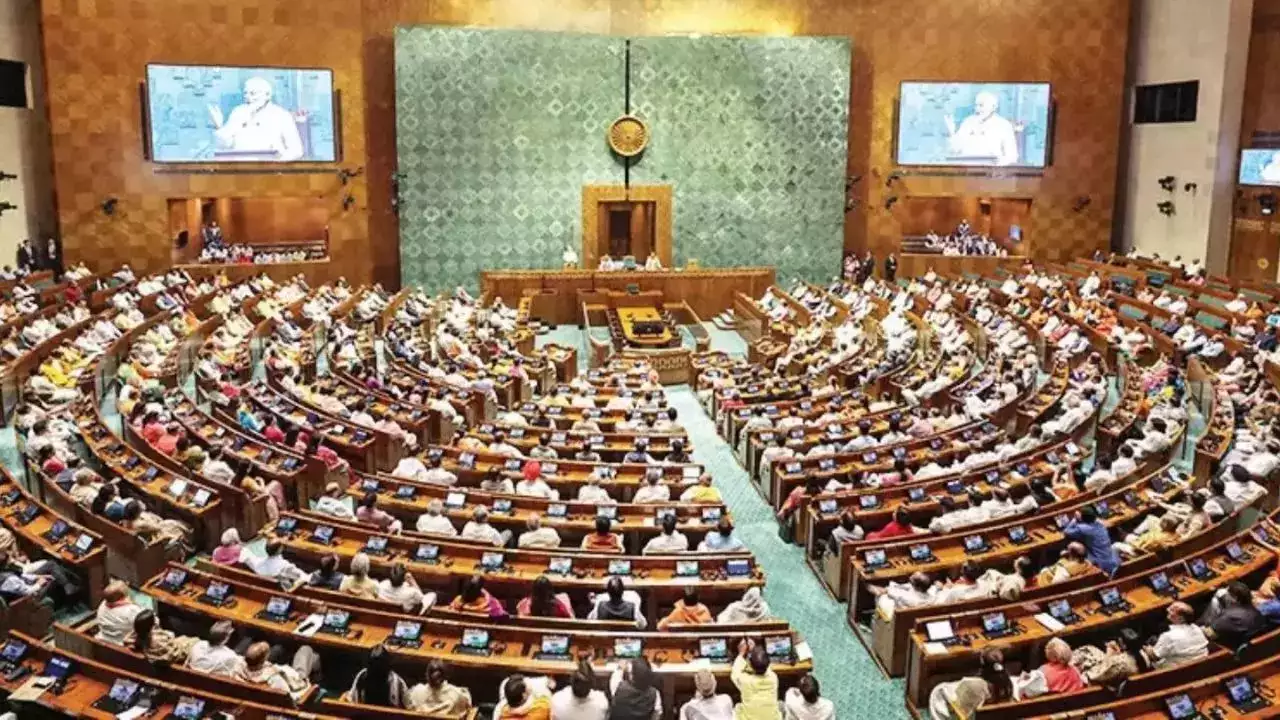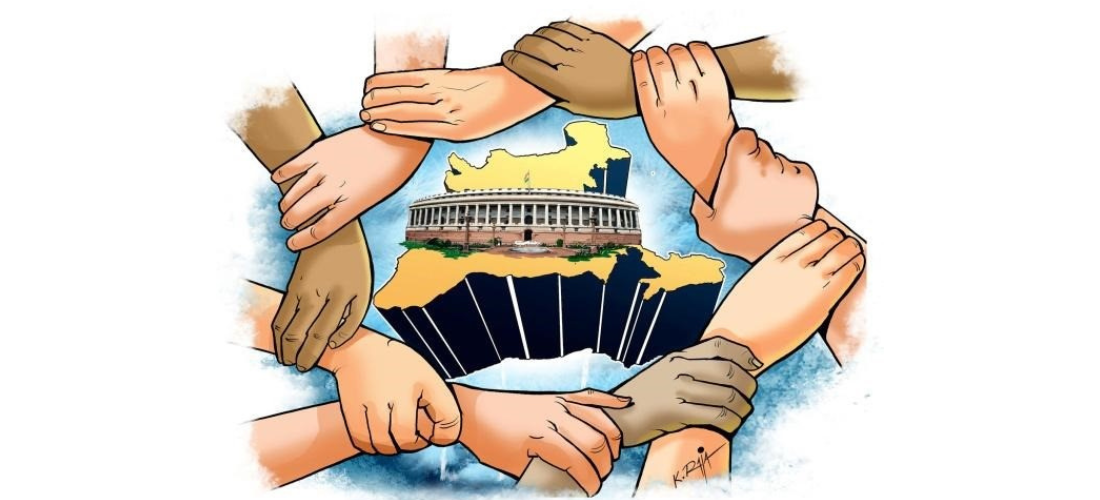- Courses
- GS Full Course 1 Year
- GS Full Course 2 Year
- GS Full Course 3 Year
- GS Full Course Till Selection
- Answer Alpha: Mains 2025 Mentorship
- MEP (Mains Enrichment Programme) Data, Facts
- Essay Target – 150+ Marks
- Online Program
- GS Recorded Course
- Polity
- Geography
- Economy
- Ancient, Medieval and Art & Culture AMAC
- Modern India, Post Independence & World History
- Environment
- Governance
- Science & Technology
- International Relations and Internal Security
- Disaster Management
- Ethics
- NCERT Current Affairs
- Indian Society and Social Issue
- NCERT- Science and Technology
- NCERT - Geography
- NCERT - Ancient History
- NCERT- World History
- NCERT Modern History
- CSAT
- 5 LAYERED ARJUNA Mentorship
- Public Administration Optional
- ABOUT US
- OUR TOPPERS
- TEST SERIES
- FREE STUDY MATERIAL
- VIDEOS
- CONTACT US
Joint Sitting of Parliament (Article 108)
Joint Sitting of Parliament (Article 108)

What is the Joint Sitting of Parliament?
- The Joint Sitting of Parliament is when both the Lok Sabha (House of the People) and Rajya Sabha (Council of States) meet together to resolve disagreements on a bill.
- This can happen when the two Houses can't agree on a bill, and the President calls for a joint sitting to resolve this under article 108.
Where did the idea of a joint sitting come from?
- The idea was taken from the Government of India Act, 1935
- It is also found in the laws of other countries like the USA, Canada, and Britain.
Why was the joint sitting added to the Indian Constitution?
- India has a bicameral legislature which means 2 houses .
- Any law must be approved by both Houses (the Lok Sabha and the Rajya Sabha) before the President can sign it.
- The framers of the Constitution expected disagreements between the Lok Sabha and Rajya Sabha, so they created the joint sitting to resolve these conflicts.
What are the reasons a joint sitting can be called?
A joint sitting can be called if:
- Deadlock on the Bill: One House passes the bill, but the other rejects it.
- Conflicting Amendments: The two Houses suggest different amendments to the bill.
- 6-Month Delay: If a bill is stuck in one House for more than 6 months.
Exceptions to Joint Sitting
Are there any bills that can’t be discussed in a joint sitting?
Yes, these bills can’t be discussed in a joint sitting:
- Money Bill: Money Bills can only be introduced in the Lok Sabha. If the Rajya Sabha doesn’t pass them within 14 days, they are automatically passed.
- Constitution Amendment Bill: These need a two-thirds majority in both Houses according to Article 368, so no joint sitting is allowed.
- Dissolution of Lok Sabha: If the Lok Sabha is dissolved after a bill is passed, a joint sitting can’t happen.
- However, the joint sitting can take place if the Lok Sabha is dissolved after the President has announced his desire to call such a meeting (as the bill does not lapse in this case).
- After the President announces his intention to call a joint session of the two Houses, neither House can take action on the measure.
- In a joint session, no new amendments to the bill may be presented, with the exception of those passed by one House and rejected by the other.
- This means that in a joint session, only amendments that have already been considered and disagreed upon by the two Houses can be presented.
- This helps to ensure that the joint session is focused on resolving the specific disagreements between the two Houses, rather than opening up the bill to further changes.
Who can call for a joint sitting?
- The President of India can call for a joint sitting after consulting the Speaker of Lok Sabha and the Chairman of Rajya Sabha according to Article 118
Who Presides the Joint sitting?
- The Speaker of the Lok Sabha Presides the joint sitting.
- If they’re not available, the Deputy Speaker will preside.
- If both are absent, the Deputy Chairman of Rajya Sabha Presides.
Can the Chairman of Rajya Sabha lead the joint sitting?
- No, the Chairman of Rajya Sabha cannot Preside the joint sitting to keep things fair.
How many members are needed for a joint sitting to happen?
- A joint sitting needs at least one-tenth of the total members of both Houses.
Which House’s rules are followed in a joint sitting?
- The rules of the Lok Sabha are followed, not the Rajya Sabha’s.
What are the problems with joint sittings?
Some people say joint sittings have issues like:
- Lok Sabha’s Advantage: Since the Lok Sabha has more members, the ruling party there may have more power in a joint sitting.
- Majority Advantage: If the ruling party has a majority in Lok Sabha but not in Rajya Sabha, they could use the joint sitting to push through bills that might not be carefully examined by Rajya Sabha.
How many times have joint sittings happened before?
- Only 3 times in India:
- First joint sitting was conducted in the year 1961
- Dowry Prohibition Bill, 1959 was passed at the joint sitting
- The second joint sitting was held on 16 May 1978
- Banking Service Commission (Repeal) Bill, 1977 passed at a joint sitting
- The third joint sitting was held on 26 March 2002
- Prevention of Terrorism Bill 2002 passed at a joint sitting of Parliament
- Prevention of Terrorism Bill 2002 passed at a joint sitting of Parliament
What is Article 87 ?
- Article 87 of the Indian Constitution deals with the President's special address to both Houses of Parliament assembled together,
- It essentially outlines a "joint session" where the President addresses the Lok Sabha and Rajya Sabha at the commencement of the first session after each general election and at the beginning of the first session of each year;
- This is also considered a joint session under Article 87.
So how is it different from Article 108?
|
Feature |
Article 87: President's Address |
Article 108: Joint Sitting to Resolve Deadlock |
|
Purpose |
President's address to both Houses of Parliament. |
To resolve a legislative deadlock between the two Houses. |
|
Occasion |
Beginning of the first session after each general election; Beginning of the first session of each year. |
When a bill passed by one House is rejected/not passed by the other, or Houses disagree on amendments. |
|
Initiation |
Related to the President's function. |
Initiated by a deadlock in the legislative process. |
|
Focus |
Government policy and legislative agenda. |
Passage of a specific bill. |
|
Also Read |
|
| NCERT Books For UPSC | |
| UPSC Monthly Magazine | Best IAS Coaching in Delhi |


